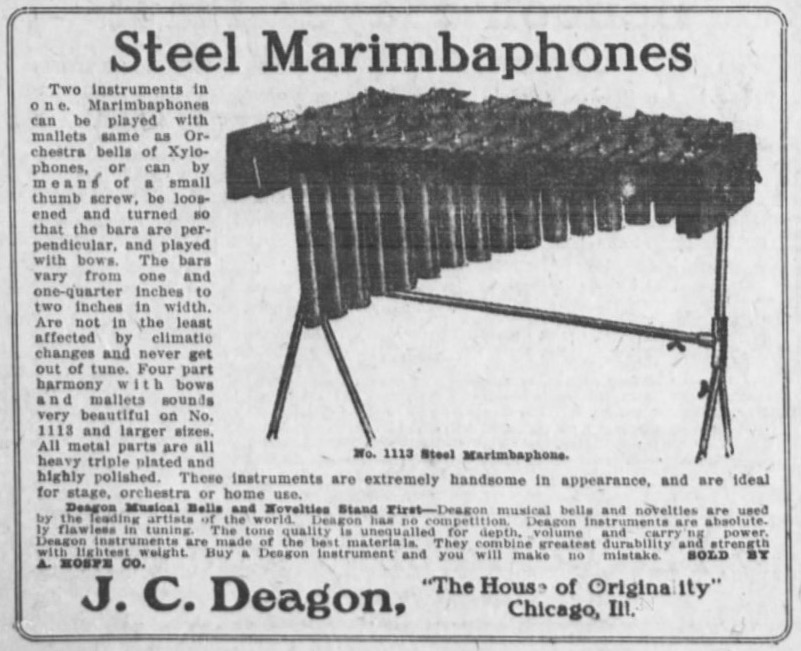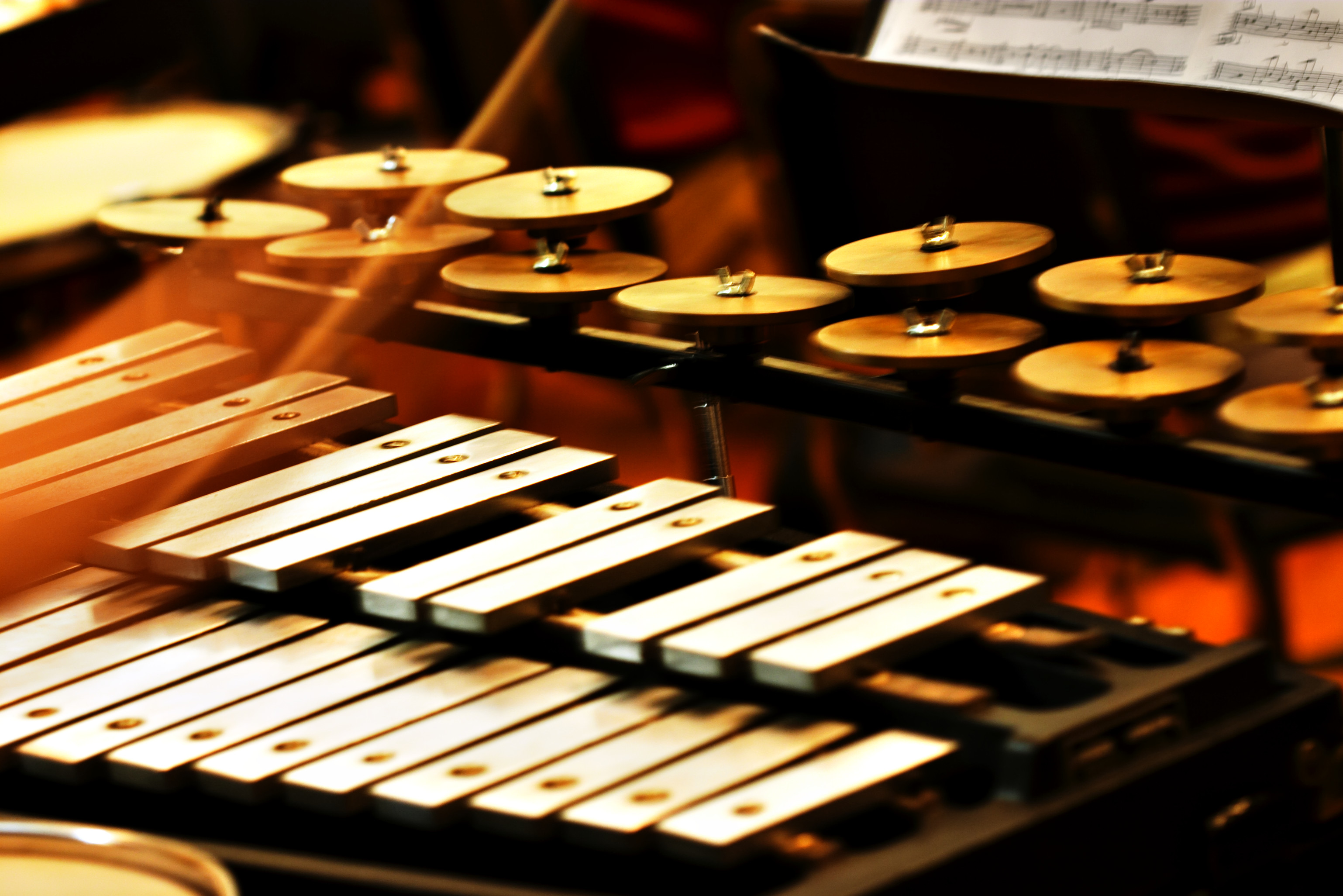|
Marimbaphone
The marimbaphone is an obsolete tuned percussion instrument, developed by J. C. Deagan, Inc., of Chicago, Illinois, in the early 20th century. Description The marimbaphone had either shallow steel or wooden bars arranged chromatically with a tube resonator under each bar with wooden bars with resonators shorter than steel bars with resonators sounding its corresponding notes. Its timbre was similar to the celesta for steel and marimba for wooden, and it was used mainly by marimba bands and as a solo instrument by stage artists. It also had an alto version made of steel bars and Tenor version made of nagaed (wooden) bars. In addition to being played with mallets in the conventional way (as in the playing of a marimba or vibraphone), the marimbaphone was designed so that its bars could be rotated from a horizontal position to a vertical position, allowing them to more easily be played with a bow. To further facilitate bowing, the ends of its bars were shaped to be concave rather t ... [...More Info...] [...Related Items...] OR: [Wikipedia] [Google] [Baidu] |
Xylorimba
The xylorimba (sometimes referred to as xylo-marimba or marimba-xylophone) is a pitched percussion instrument similar to an extended-range xylophone with a range identical to some 5-octave celestas or 5-octave marimbas, though typically an octave higher than the latter. Despite its name, it is not a combination of a xylophone and a marimba; its name has been a source of confusion, as many composers have called for a 'xylorimba', including Alban Berg, Pierre Boulez and Olivier Messiaen, but for parts requiring only a four-octave xylophone. However, Pierre Boulez wrote for two five-octave xylorimbas in . Like the xylophone and marimba, the xylorimba consists of a series of wooden bars laid out like a piano keyboard "with a compass sufficiently large to embrace the low-sounding bars of the marimba and the highest-sounding bars of the xylophone." The lower notes of the xylorimba are described as sounding closer to a xylophone than a marimba, on account of its bars being both thicker ... [...More Info...] [...Related Items...] OR: [Wikipedia] [Google] [Baidu] |
Marimba
The marimba ( ) is a musical instrument in the percussion family that consists of wooden bars that are struck by mallets. Below each bar is a resonator pipe that amplifies particular harmonics of its sound. Compared to the xylophone, the marimba has a lower range. Typically, the bars of a marimba are arranged chromatically, like the keys of a piano. The marimba is a type of idiophone. Today, the marimba is used as a solo instrument, or in ensembles like orchestras, marching bands (typically as a part of the front ensemble), percussion ensembles, brass band, brass and concert bands, and other traditional ensembles. Etymology and terminology The term ''marimba'' refers to both the traditional version of this instrument and its modern form. Its first documented use in the English language dates back to 1704. The term is of Bantu languages, Bantu origin, deriving from the prefix meaning 'many' and meaning 'xylophone'. The term is akin to kongo languages, Kikongo and Swahili ... [...More Info...] [...Related Items...] OR: [Wikipedia] [Google] [Baidu] |
Chicago, Illinois
Chicago is the List of municipalities in Illinois, most populous city in the U.S. state of Illinois and in the Midwestern United States. With a population of 2,746,388, as of the 2020 United States census, 2020 census, it is the List of United States cities by population, third-most populous city in the United States after New York City and Los Angeles. As the county seat, seat of Cook County, Illinois, Cook County, the List of the most populous counties in the United States, second-most populous county in the U.S., Chicago is the center of the Chicago metropolitan area, often colloquially called "Chicagoland" and home to 9.6 million residents. Located on the shore of Lake Michigan, Chicago was incorporated as a city in 1837 near a Chicago Portage, portage between the Great Lakes and the Mississippi River, Mississippi River watershed. It grew rapidly in the mid-19th century. In 1871, the Great Chicago Fire destroyed several square miles and left more than 100,000 homeless, but ... [...More Info...] [...Related Items...] OR: [Wikipedia] [Google] [Baidu] |
Timbre
In music, timbre (), also known as tone color or tone quality (from psychoacoustics), is the perceived sound of a musical note, sound or tone. Timbre distinguishes sounds according to their source, such as choir voices and musical instruments. It also enables listeners to distinguish instruments in the same category (e.g., an oboe and a clarinet, both woodwinds). In simple terms, timbre is what makes a particular musical instrument or human voice have a different sound from another, even when they play or sing the same note. For instance, it is the difference in sound between a guitar and a piano playing the same note at the same volume. Both instruments can sound equally tuned in relation to each other as they play the same note, and while playing at the same amplitude level each instrument will still sound distinctive with its own unique tone color. Musicians distinguish instruments based on their varied timbres, even instruments playing notes at the same pitch and volume ... [...More Info...] [...Related Items...] OR: [Wikipedia] [Google] [Baidu] |
Celesta
The celesta () or celeste (), also called a bell-piano, is a struck idiophone operated by a keyboard. It looks similar to an upright piano (four- or five-octave), albeit with smaller keys and a much smaller cabinet, or a large wooden music box (three-octave). The keys connect to hammers that strike a graduated set of metal (usually steel) plates or bars suspended over wooden resonators. Four- or five-octave models usually have a damper pedal that sustains or damps the sound. The three-octave instruments do not have a pedal because of their small "table-top" design. One of the best-known works that uses the celesta is Pyotr Ilyich Tchaikovskys "Dance of the Sugar Plum Fairy" from ''The Nutcracker''. The sound of the celesta is similar to that of the glockenspiel, but with a much softer and more subtle timbre. This quality gave the instrument its name, ''celeste'', meaning "heavenly" in French. The celesta is often used to enhance a melody line played by another instrument or ... [...More Info...] [...Related Items...] OR: [Wikipedia] [Google] [Baidu] |
Vibraphone
The vibraphone (also called the vibraharp) is a percussion instrument in the metallophone family. It consists of tuned metal bars and is typically played by using Percussion mallet, mallets to strike the bars. A person who plays the vibraphone is called a ''vibraphonist,'' ''vibraharpist,'' or ''vibist''. The vibraphone resembles the Marimbaphone, steel marimba, which it superseded. One of the main differences between the vibraphone and other keyboard percussion instruments is that each bar suspends over a resonator tube containing a flat metal disc. These discs are attached together by a common axle and spin when the motor is turned on. This causes the instrument to produce its namesake tremolo or vibrato effect. The vibraphone also has a sustain pedal similar to a piano. When the pedal is up, the bars produce a muted sound; when the pedal is down, the bars sustain for several seconds or until again muted with the pedal. The vibraphone is commonly used in jazz music, in which ... [...More Info...] [...Related Items...] OR: [Wikipedia] [Google] [Baidu] |
Percy Grainger
Percy Aldridge Grainger (born George Percy Grainger; 8 July 188220 February 1961) was an Australian-born composer, arranger and pianist who moved to the United States in 1914 and became an American citizen in 1918. In the course of a long and innovative career he played a prominent role in the revival of interest in Music of the United Kingdom, British folk music in the early years of the 20th century. Although much of his work was experimental and unusual, the piece with which he is most generally associated is his piano arrangement of the Folk dance, folk-dance tune "Country Gardens". Grainger left Australia at the age of 13 to attend the Hoch Conservatory in Frankfurt. Between 1901 and 1914 he was based in London, where he established himself first as a society pianist and later as a concert performer, composer, and collector of original folk melodies. As his reputation grew he met many of the significant figures in European music, forming important friendships with Frederic ... [...More Info...] [...Related Items...] OR: [Wikipedia] [Google] [Baidu] |
Tuned Percussion
A pitched percussion instrument (also known as a melodic or tuned percussion instrument) is a percussion instrument used to produce musical notes of one or more pitches, as opposed to an unpitched percussion instrument which is used to produce sounds of indefinite pitch. Pitching of percussion instruments is achieved through a variety of means. *Membranophones (such as timpani) are tuned by altering the surface tension of the face that is struck. *Idiophones (such as xylophone) gain their pitch through the physical characteristics (such as composition, density, and physical dimensions) of each respective bar. The term ''pitched percussion'' is now preferred to the traditional term ''tuned percussion'': * Many ''untuned'' percussion instruments (such as the bass drum) are ''tuned'' by the player, but this tuning does not relate to a particular pitch. * ''Untuned'' percussion instruments can and frequently do make sounds that could be used as pitched notes in an appropriate ... [...More Info...] [...Related Items...] OR: [Wikipedia] [Google] [Baidu] |





